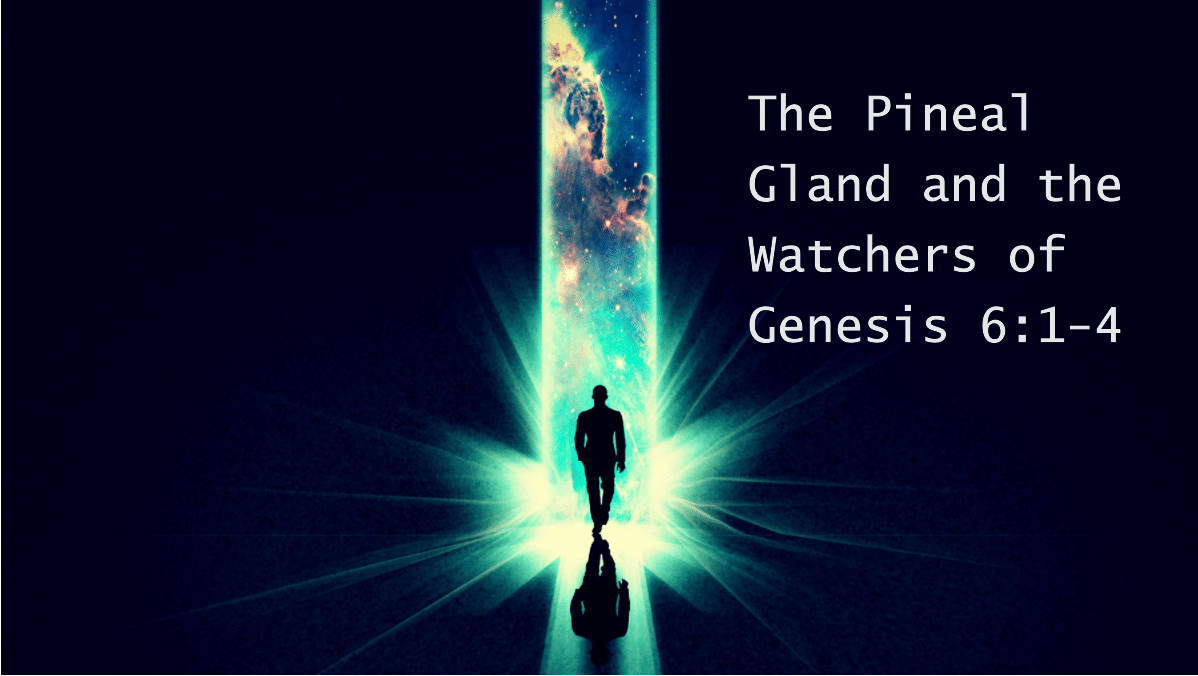The Pineal gland, a small endocrine gland located in the center of the brain, has long been associated with spiritual experiences and altered states of consciousness. In addition, recent research has also linked disorders of the pineal gland to premature puberty, which can lead to humans of large size (not gigantism, but “giants.”)
These connections remind me of Genesis 6:1-4, when spiritual beings cohabitated with human women, to produce giants, who became the semi-mythical heroes of Babylon and other ancient cultures (Annus 2010). The biblical authors made it clear that these were not actually heroes to be honored, but in fact contributed to the general human wickedness that resulted in the great flood.
While I take the passage seriously and theologically, I have mixed thoughts about how it played out historically or in the physical realm. Some have no problem with the concept of spiritual creatures taking on human forms and performing human functions. After all, many angels in the Bible interact physically with humans: eating, drinking, wrestling, slapping…
Perhaps these spiritual creatures, called Watchers in the ancient world, interacted with human women in ways that they could not quite understand, but which involved spiritual interactions related to sex that produced giants somehow. Ancient writers simply wrote about it as if they took on physical form and had sex with women.
There are other ways to interpret Genesis 6:1-4 but I wanted to do a brief survey of modern medical literature regarding the pineal gland and propose a potential interpretation: the Watchers of Genesis 6, perhaps in league with wicked human priests or kings, interacted with women spiritually and sexually, and manipulated their offspring in subtle, almost imperceptible ways, through the pineal gland, thought by mystics even in ancient Egypt to be a spiritual doorway for the human soul.
Modern studies have shown that sex hormones, prolactin, and chorionic gonadotropin can affect the electrical activity of the pineal gland in guinea pigs, indicating a relationship between the pineal gland and reproductive hormones (Semm, Demaine, and Vollrath, 1981). In humans, the pineal gland produces the hormone melatonin, which is known to regulate sleep-wake cycles and dream experiences, and is influenced by sex hormones. In fact, a review of research on melatonin and sex hormone interrelationships found that melatonin secretion is modulated by sex hormones and can affect the reproductive system (Luboshitzky and Lavie, 1999).
One disorder of the pineal gland that has been linked to premature puberty is pineal cysts. In a study of children with precocious puberty, it was found that a pineal cyst could stimulate the release of gonadotropins, which can cause the onset of puberty in children as young as 4 years old (Dickerman et al., 2004). Another study found that pineal gland lesions could cause precocious puberty by disrupting the hypothalamic-pituitary axis (Kitay, 1954). This precocious puberty in children often resulted in extremely large adults (particularly males) – much larger than average. In some cases, especially girls, precocious puberty fused growth plates such that girls had shorter legs than average with larger torsos than average.
The pineal gland has also been associated with the production of N,N-Dimethyltryptamine (DMT), a powerful psychedelic compound that is believed by some to be responsible for mystical and spiritual experiences. However, the relationship between DMT and the pineal gland is still a matter of debate. While some researchers have suggested that the pineal gland may be involved in the production of DMT, others have pointed out that there is no evidence to support this claim (Nichols, 2018).
Despite the lack of evidence for the pineal gland’s direct involvement in DMT production, some researchers have suggested that the gland may still play a role in spiritual experiences. One theory is that the pineal gland may act as a mediator of spiritual experiences by regulating the release of neurotransmitters and hormones associated with altered states of consciousness (Miller, 2013). Others have suggested that the pineal gland may be sensitive to subtle energetic influences, such as those associated with spiritual practices like meditation and prayer (Luke, 2011).
Research suggests some evidence that LSD and other psychoactive drugs may impact the pineal gland function and melatonin secretion (Srinivasan, 1989). Psychotropic drugs, including antidepressants, can cause significant changes in pineal indoleamine content, including melatonin, which is synthesized in the pineal gland (Wakabayashi, 1989).
Interestingly, some cultural and historical perspectives on the pineal gland also suggest a connection between the gland and spiritual experiences. In the 1940s, Spiritism, a spiritualist philosophy that originated in Brazil, posited that the pineal gland was the seat of the soul and the source of spiritual experiences. While this theory may seem outdated today, it is interesting to compare it with current scientific evidence on the pineal gland (Lucchetti et al., 2013).
In conclusion, the pineal gland is a fascinating area of study that has been linked to a variety of physiological and spiritual phenomena. While the relationship between the pineal gland and DMT is still a matter of debate, research has shown that the gland plays a role in regulating sleep-wake cycles and is influenced by sex hormones. Moreover, disorders of the pineal gland have been linked to premature puberty, suggesting a connection between the gland and the reproductive system, which results in extremely large humans. As research on the pineal gland continues, we may gain further insight into the nature of spiritual experiences and altered states of consciousness.
As stated elsewhere on this site, attempting to manipulate the pineal gland for spiritual experiences is not helpful. God wants to commune with us in the physical realm (1 John 1:1-4), not in an altered or disembodied state of consciousness.
(That’s not to say God doesn’t speak in dreams or during a Holy Spirit-induced trance or through other moves of the Holy Spirit. It’s just to say we are physical beings and God wants to commune with us in our current state, not in a disembodied state).
It’s unwise to pursue spiritual experiences for their own sake; but rather pursue relationship with Jesus, both directly and through relationships with other people. We want a closer walk with the Lord, individually and corporately, but not …disembodied-ly.
For Christians, the pineal gland is not the temple of the Holy Spirit, but the entire physical body is.
How the events of Genesis 6 and related events in the Bible and through history actually took place kind of misses the point: angels have their estate (the spiritual realm) and we have our estate (the physical realm). Crossing the border is not helpful. God wants to bless us here on earth, and our eternal destiny as Christians is in physical, resurrected bodies, communing forever with each other and the Lord.
Pursue God’s rule in your life and land, and don’t worry too much about the pineal gland.
But if you have a hard time taking the Bible seriously because of Genesis 6, then consider this as an alternate solution to the conundrum. Don’t allow hyper-literalism of mythical (that is, stories that involve the supernatural with the natural) events dissuade you from the truth of scripture and the sovereignty of the Lord Jesus Christ.
He is King, and his kingdom is here, and it’s coming.
Sources:
Annus, Amar. “On the Origin of Watchers: A Comparative Study of the Antediluvian Wisdom in Mesopotamian and Jewish Traditions.” Journal for the Study of the Pseudepigrapha 19, no. 4 (May 2010): 277-320
Axelrod, J. “The Pineal Gland.” Canadian Medical Association Journal 106, no. 1 (1972): 43-48
Dickerman, R., Stevens, Q., Steide, J., and Schneider, S. “Precocious Puberty Associated with a Pineal Cyst: Is It Disinhibition of the Hypothalamic-Pituitary Axis?” Neuro – endocrinology letters 25, no. 1-2 (2004): 47-50
Kitay, J. “Pineal Lesions and Precocious Puberty: A Review.” Journal of Clinical Endocrinology and Metabolism 14, no. 10 (1954): 1219-1239
Lucchetti, G., Daher, J. C., Iandoli, D., Gonçalves, J. P., and Lucchetti, A. “Historical and Cultural Aspects of the Pineal Gland: Comparison Between the Theories Provided by Spiritism in the 1940s and the Current Scientific Evidence.” Neuro – Endocrinology Letters 34, no. 8 (2013): 745-752
Luboshitzky, R., and Lavie, P. “Melatonin and Sex Hormone Interrelationships – A Review.” Journal of Pediatric Endocrinology & Metabolism (JPEM) 12, no. 5 (1999): 607-616
Luke, D. “Discarnate Entities and Dimethyltryptamine (DMT): Psychopharmacology, Phenomenology and Ontology.” Journal of the Society for Psychical Research 75, no. 1 (2011): 26-42
Miller, I. “Pineal Gland, DMT & Altered State of Consciousness.” Biology 2, no. 1 (2013): 1-12
Nichols, D. “N,N-Dimethyltryptamine and the Pineal Gland: Separating Fact from Myth.” Journal of Psychopharmacology 32, no. 1 (2018): 7-9
Semm, P., Demaine, C., and Vollrath, L. “The Effects of Sex Hormones, Prolactin, and Chorionic Gonadotropin on Pineal Electrical Activity in Guinea Pigs.” Cellular and Molecular Neurobiology 1, no. 3 (1981): 277-288
Silman, R. E., Leone, R. M., Hooper, R. J. L., and Preece, M. A. “Melatonin, the Pineal Gland and Human Puberty.” Nature 282, no. 5739 (1979): 301-303
Srinivasan, Venkatramanujan. “Psychoactive drugs, pineal gland and affective disorders.” Progress in Neuro-Psychopharmacology and Biological Psychiatry (1989): 527-535.
Wakabayashi, H., Shimada, K., Aizawa, Y., & Satoh, T. “Effect of psychotropic drugs on the contents of melatonin, serotonin and N-acetylserotonin in rat pineal gland.” Japanese Journal of Pharmacology (1989): 117-123.


Thank you, Doug, I have never worried myself about science and spirituality, in fact I think science is man’s explanation of the world and who we are, but spirituality has a deeper understanding of the human interaction and experiences, and it is based on your belief in God so mixing the two is chaos.
Sonia, I tend to agree. The post was to help some who are in the chaos to think through it.
💙
A little history reveals how the antiquated view of the pineal gland/soul idea evolved by assumption. Without doing basic research, people still attribute this gland to spirit/soul phenomena.
https://plato.stanford.edu/entries/pineal-gland/
Yeah, it’s really interesting how so much mythology built around it. Someone asked me if I thought pine-cone shaped iconography in the ancient world related to it. I was like… “maybee???” But I suspect it’s rather like seeing UFO’s in ancient iconography: there are better and culturally appropriate explanations.
Thanks for the great link!
Wow kudos you answered right away and to all of those who answered here is a verbal rose boque and a smile